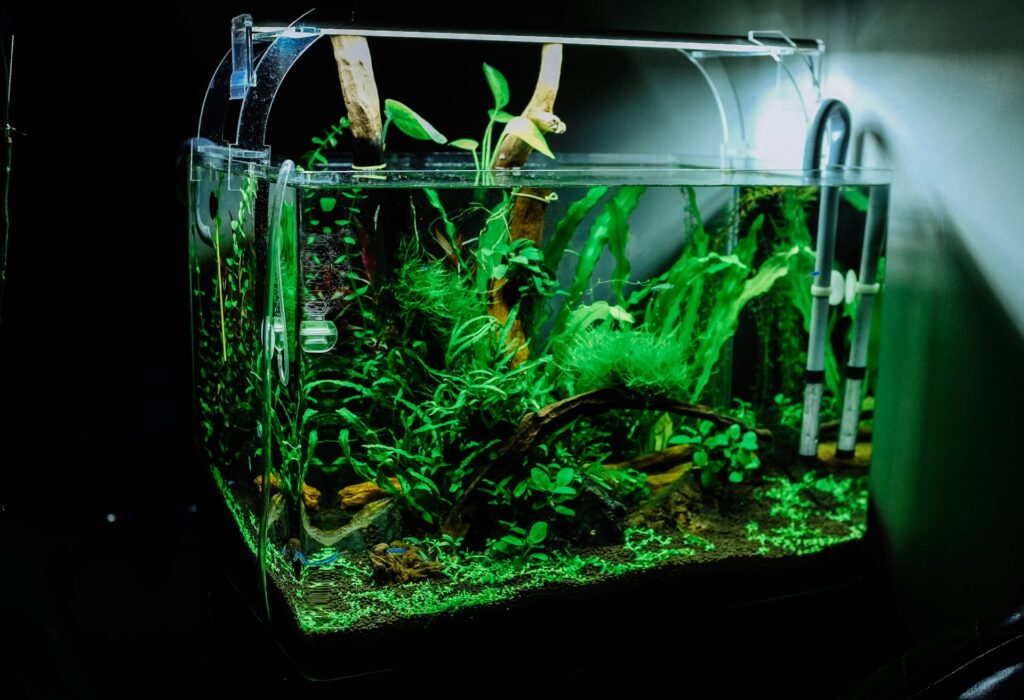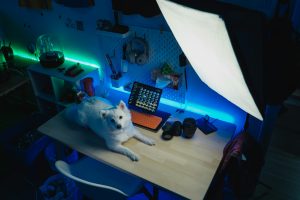
15 Brilliant Fish Tank Apartment Setup Tips (Quiet, Clean, and Stress-Free)
A well-planned fish tank apartment setup can turn even the smallest space into a calming underwater oasis. Aquariums add life and movement, but without the right prep they can cause noise, mess, or maintenance headaches for renters. The key is balance: creating a stable, quiet environment for your fish that also fits neatly and safely into your apartment layout.
In this guide, you’ll discover fifteen practical, renter-friendly ways to maintain crystal-clear water, keep filters whisper-quiet, protect furniture from moisture, and prevent odors before they start. Whether you’re keeping a simple bowl setup or a 20-gallon community tank, these tips will make your aquatic corner easy to manage—and even easier to enjoy.
1. Choose the Right Tank Size for Apartment Living
The first step in your fish tank apartment setup is sizing. Smaller tanks are tempting, but they’re often harder to maintain—temperature and water chemistry can fluctuate quickly. For beginners, aim for at least **10 to 20 gallons** if space allows. That size gives fish room to swim, keeps conditions more stable, and still fits comfortably on a compact stand or sideboard.
Avoid placing the aquarium on glass tables or flimsy surfaces; water is heavy (one gallon weighs about 8.3 pounds). If you’re short on room, consider a **tall, narrow tank** rather than a wide one. For renters who want ultra-small setups, refer to PetMD’s list of fish that can live in bowls—but always provide proper filtration and frequent partial water changes to keep conditions healthy.
2. Pick a Quiet Filter and Stable Surface to Protect Floors
A noisy filter is the fastest way to turn your peaceful aquarium into background frustration. Look for **internal sponge or canister filters** labeled “whisper” or “ultra-quiet,” and always place a soft pad under the tank to absorb vibration. A stable, water-resistant stand is crucial—many aquarium leaks start from uneven furniture that slowly flexes under weight.
If you live in a multi-level apartment, use a **rubber or silicone mat** beneath the stand to protect floors from moisture and dampen sound. Avoid placing the tank near heaters, vents, or balconies; sudden drafts or direct sunlight can spike temperatures. For long-term renters, review our pet-proof apartment tips to keep cords, outlets, and wood furniture safe from splashes and humidity.
3. Place the Aquarium Where It’s Safe, Level, and Draft-Free
The perfect spot for your tank balances light, stability, and silence. Choose an interior wall that stays consistently cool, away from direct sun or heaters. Direct sunlight can trigger algae blooms and raise water temperatures; vents and windows create drafts that stress fish. Avoid high-traffic corners or TV stands where vibration and sudden motion startle your fish.
Ideally, keep the top of the tank at **eye level when seated**—this reduces light glare and keeps the view calming. If you’re unsure about how placement affects maintenance noise, The Spruce Pets’ aquarium cleaning guide explains how location impacts water clarity and access for siphoning.
4. Use Renter-Friendly Cable Management and Drip Protection
Apartment outlets are often placed far from ideal tank spots, so tidy cable management is essential. Run cords through **adhesive cord clips or plastic raceways** that remove cleanly without damaging walls. Loop cables into a drip loop (a gentle U-shape below the outlet) to prevent water from reaching the socket during spills. Secure light timers and filter plugs on a nearby surge protector mounted vertically—easier to switch off during maintenance.
For safety, check cords weekly for condensation or salt creep. If moisture builds near outlets, relocate the strip higher or use a **drip-shielded power box**. To protect furniture and baseboards, combine this with the renter-safe tricks from our pet-proof apartment guide.
5. Choose Low-Maintenance Fish and Plants That Fit Small-Space Living
In small apartments, your time and filtration are limited, so pick hardy species that thrive in moderate conditions. Beginner-friendly fish like **guppies, white clouds, zebra danios, or bettas** tolerate gentle fluctuations and are peaceful for community setups. Add low-light plants such as **Anubias, Java fern, or marimo moss balls** to improve water quality and absorb nitrates naturally. Live plants also reduce noise by diffusing filter output and give the tank a lush look.
Keep stocking light—roughly one inch of fish per gallon for smaller species—and research compatibility before mixing. Fewer fish means fewer water changes and quieter filtration. For renters who prefer a minimalist setup, a single betta or trio of snails in a planted 5-gallon can look elegant and stay stable with minimal upkeep.
6. Quiet the Equipment: Pads, Mats, and Proper Filter Placement
Even “silent” filters and air pumps can hum through apartment floors and walls. To reduce vibration, place a rubber or silicone mat under the tank and equipment, and wedge a small foam pad beneath the air pump. Ensure filter hoses and lids fit snugly—rattling parts amplify noise. Internal sponge filters or small canisters generally run quieter than hang-on-back units, which can vibrate against glass.
You can also decouple the stand from the wall by leaving a 1-inch gap behind it to prevent resonance. This keeps your fish relaxed and helps you maintain a calm, spa-like vibe in your fish tank apartment setup. If noise persists, double-check water levels: when the level drops too low, falling water increases splashing sounds.
7. Manage Odors with Routine Care and Natural Fresheners
A healthy tank shouldn’t smell fishy—it should have only a faint earthy scent. Odors come from leftover food, dirty filters, or stagnant water. Feed lightly (your fish should finish food within two minutes) and rinse filter media in removed tank water once a month, never under the tap. Do a 25% water change weekly, vacuuming debris from gravel to prevent buildup.
To keep your apartment air fresh, open windows briefly during water changes and place a small houseplant like peace lily or pothos near (but not inside) the tank—they help absorb airborne humidity and mild odors. For deeper scent control across your home, check out our ultimate pet odor-control guide.
8. Keep Cleaning Simple with Compact Tools and Scheduled Maintenance
Apartments don’t have room for bulky aquarium gear, so streamline your maintenance kit. Store a gravel vacuum, algae magnet, microfiber cloth, and small bucket inside your stand. Label the bucket “fish only” to avoid detergent contamination. Once a week, siphon debris from the substrate, refill with dechlorinated water, and wipe glass with a magnetic cleaner or algae pad.
Keep cleaning days consistent—your fish adapt to predictable motion and light changes. Set a recurring phone reminder or calendar event for water-change day, and keep a printed 5-step checklist in the stand so it’s grab-and-go.
9. Cycle the Tank and Track Water Quality with a Simple Weekly Routine
Stability beats constant tinkering in a fish tank apartment setup. Before adding a full stock, establish the biological cycle and then maintain it with a quick weekly cadence: test ammonia, nitrite, nitrate, and pH, clean the pre-filter sponge, and change ~25% of the water. Rinse any media in removed tank water (never the tap) to preserve beneficial bacteria. Keep a small notebook or phone note with your readings—seeing trends prevents emergencies and reduces odors.
Apartment tip: store your liquid test kit, dechlorinator, and a turkey baster (for spot cleanups) in a labeled shoebox inside the stand so everything is grab-and-go and nothing clutters countertops.
10. Make Water Changes Spill-Proof with a Sink-Friendly Kit
Small spaces demand neat maintenance. Build a compact kit: a gravel vacuum that can connect to a faucet or bucket, a “fish-only” bucket (no detergents ever), a microfiber towel, and a silicone splash mat under the stand. Create a drip loop on every cord and mount your power strip vertically on the wall or stand leg so splashes can’t run into outlets.
If your sink is far, fill fresh water in the tub and use a small pump with tubing to return it quietly to the tank—no sloshing through the living room. For renter-safe wall and baseboard protection near the setup, borrow ideas from our pet-proof apartment tips.
11. Set “Night Mode”: Timers, Light Discipline, and Quiet Hours
Light control keeps algae down and apartments peaceful. Put your lights on a timer (8–10 hours daily), skip overnight blue LEDs, and keep the tank away from direct evening glare. If reflections spook fish at night, angle a lamp or use sheer curtains. Pair night mode with a quick pre-bed check: confirm water level (less waterfall noise), ensure the lid sits flat (no rattles), and silence air pump hum with a foam pad.
For true peace of mind in a rental, keep a tiny “just-in-case” plan: a towel stack, spare power strip, and a printed list of shutoff steps. For broader readiness across your home, see our apartment emergency preparedness guide.
12. Use Natural Décor for Beauty and Better Balance
In small apartments, your aquarium doubles as living décor. Opt for natural elements—smooth river stones, driftwood, and real plants—to create a balanced look that blends with your furniture. Natural décor helps regulate water chemistry too: driftwood gently softens pH, and live plants absorb nitrates that can cloud the water or cause odors.
Keep decorations simple and functional. Fewer large pieces are easier to clean around than many tiny ones. Avoid sharp fake corals or painted ornaments that can flake. Choose earthy tones and soft LED lighting to complement your interior—this keeps your fish tank apartment setup feeling calm and cohesive rather than cluttered.
13. Minimize Energy Use and Keep It Pet- and Renter-Safe
Apartment dwellers often pay close attention to power bills—and safety. Run your aquarium efficiently by using LED lights and **low-watt filters or heaters** suited to your tank’s volume. Plug all devices into a surge-protected power bar, mounted vertically to prevent drips. If your home gets warm naturally, try unheated tropical species or cool-water fish to skip the heater entirely.
Hide cords with removable raceways or behind furniture to keep curious pets and kids safe. For renters, this setup prevents cable marks on walls and keeps inspections stress-free. If you keep cats or small pets, check out our DIY pet enrichment ideas to redirect their curiosity away from the tank.
14. Keep a Minimalist Supply Drawer for Fast Upkeep
A tidy workspace makes aquarium care faster and less stressful. Dedicate one small drawer, bin, or caddy to your tank essentials: water conditioner, test kit, net, spare filter media, and microfiber towels. Label each item clearly and store them together so you’re never hunting for supplies on cleaning day. Keeping everything within arm’s reach helps prevent spills and avoids leaving wet gear on counters or tables.
For very compact apartments, consider a small rolling cart that can tuck beside your stand or under a desk. You can wheel it out for water changes, then store it away—efficient, renter-friendly, and perfect for keeping your aquarium corner uncluttered.
15. Have a Backup Plan for Power Outages and Maintenance Days
Even small tanks rely on steady filtration and aeration, so have a basic backup plan. A **battery-powered air pump** or portable power bank for your filter can protect your fish during short outages. Keep a few spare buckets and towels in a closet for emergencies, plus an extra heater or sponge filter if equipment fails.
For renters, preparation shows responsibility—your landlord will appreciate the care you take to prevent leaks or damage. Build a quick 3-step checklist: unplug devices before maintenance, dry cords and surfaces after, and check water level once you’re done. For full-home readiness, review our emergency preparedness guide for pet owners.
Final Thoughts
A balanced fish tank apartment setup can transform even the smallest space into a peaceful focal point. With quiet equipment, smart placement, and consistent routines, maintenance becomes a relaxing ritual rather than a chore. Keep everything compact, secure, and renter-safe, and you’ll enjoy clear water, healthy fish, and a home that feels calmer just by design.
Whether you’re housing a single betta or a colorful community, your aquarium can be a living piece of art that adds serenity to your daily routine—and a touch of nature that thrives right alongside you in apartment life.
Fish tank apartment setup guide: 15 brilliant tips for quiet filtration, easy cleaning, safe placement, and renter-friendly aquarium care in small living spaces.
Frequently Asked Questions
What size fish tank is best for an apartment?
For most apartments, a 10- to 20-gallon tank is ideal. It’s large enough to stay stable and easy to maintain but small enough to fit comfortably on a sturdy stand or countertop. Smaller tanks can work too, but they require more frequent cleaning and closer monitoring of water conditions.
How do I keep my fish tank quiet in an apartment?
Use a rubber or silicone mat under the tank and a foam pad beneath air pumps to reduce vibration. Choose quiet filters labeled “whisper” or “ultra-quiet,” keep water levels topped up, and ensure lids fit snugly to eliminate rattles or splashing sounds.
Where should I place my fish tank in an apartment?
Choose a level surface along an interior wall away from windows, heaters, and vents. Avoid direct sunlight to prevent algae and temperature swings. A spot near an outlet but clear of foot traffic is best for safety and easy maintenance access.
How often should I clean my apartment fish tank?
Do a 25% water change every week, rinse filter media monthly (in removed tank water, not tap water), and wipe glass or algae build-up as needed. Smaller tanks may need more frequent cleaning, while larger setups can go longer between deep cleans.
Can I keep fish in an apartment without disturbing neighbors?
Absolutely. With a quiet filter, soft matting, and consistent care, a fish tank is one of the most neighbor-friendly pets you can have. It creates gentle white noise rather than disruptive sound and adds a relaxing focal point to your home.

Join the Busy Pet Parent Newsletter!
Get easy routines, time-saving tips, and the latest gear reviews—delivered straight to your inbox.
Perfect for busy pet owners, apartment dwellers, and anyone who wants a happy, healthy companion (without the stress).
Exclusive guides & checklists
Product recommendations & deals
No spam—unsubscribe anytime!




